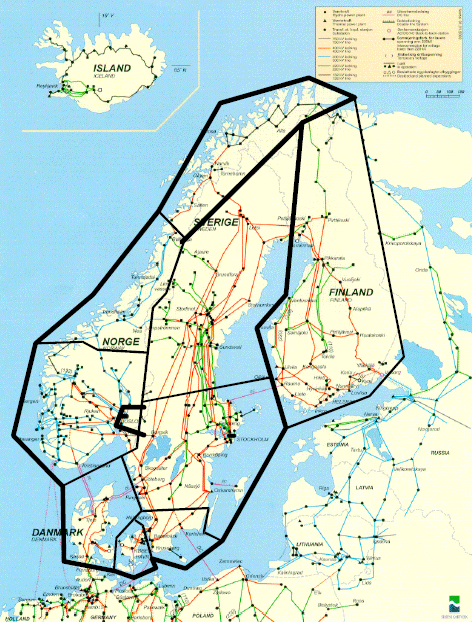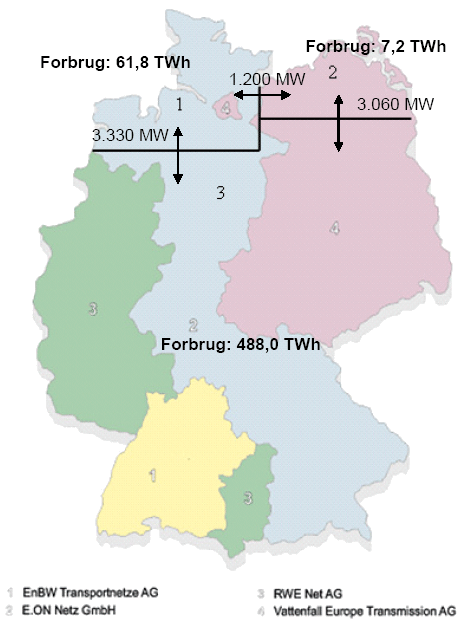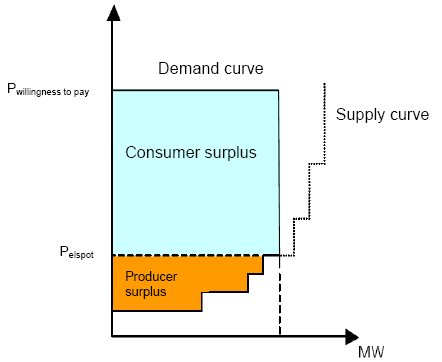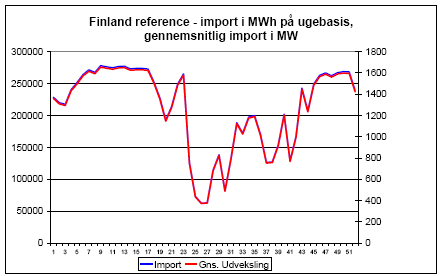Impact of CO2 quota allocation to new entrants in the electricity market
Appendix A:
Background paper on modelling tool and data assumptions
Prepared by
Ea Energy Analyses
Frederiksholms Kanal 1, 1.
1220 Kbh. K
Denmark
Modelling tool
For the present analyses it has been found necessary to work with a model working with a fine time resolution, and high detail level of the Nordic and German power and heat systems.
The Balmorel (Baltic Model of Regional Electricity Liberalisation) model is capable of fulfilling the above demands.
Balmorel - references
The Balmorel model is among others used by the Danish Transmission System Operator - Energinet.dk, the consulting group COWI, the Risø National Laboratory · Technical University of Denmark – DTU, Informatics and Mathematical Modelling at the Technical University of Denmark and EA Energy Analyses.
Studies, which have been carried out with the model, include analyses of the benefits of the Great Belt connection by Elkraft System (2005) (Transmission System Operator of Eastern Denmark until 1.1.2005), analyses of the NorNed cable for NVE (by COWI and Ramløse-EDB), simulations and analyses of the electricity markets in Poland and the Baltic countries (in connection with the project Common Baltic Electricity Market) (Eesti Energia et al., 2005) and an analysis of introducing 50 per cent wind power in the Danish electricity system (Ea Energianalyse, 2007).
For further details on the model please visit www.balmorel.com.
Geographical scope
The version of the model, which has been used for the present analyses, covers the electricity and district heating sector of the Nordic countries and Germany. In the model the Nordic countries are divided into 10 areas on the electricity side, separated by transmission links. Finland is one area, Norway consists of four areas, Sweden of three, and Denmark of two areas. The German system is divided into three areas. Figure 31 and Figure 32 show the division of the transmission grids into system areas.
Data on existing power plants in the Nordic countries have been obtained over the years on the basis of publicly accessible sources, and the data from Germany has been obtained from an EU sponsored research project on implementation of wind power in Northern Europe (WILMAR). Technical data on new plants are based on the Danish Energy Authority’s and the system operators’ Technology Catalogue (Danish Energy Authority et al, 2005).

Figure 31: The 10 transmission areas, which the Nordic system consists of in the model.

Figure 32: The three transmission areas, which the German grid consists of in the model. 1: Northwest Germany, 2: Northeast Germany, 3: Central Germany.
Optimisation model
The model simulates a well-functioning market and optimises the distribution of production between plants, including import/export conditions. The optimisation seeks to minimise the total cost of the energy system. There is full insight into the distribution of wind production, electricity consumption, inflow of water and outage of power plants. The analyses are thus based on all players having full information at a ”suitable” time before the hour of operation.
As the intention is to evaluate the socioeconomic consequences, actual costs are calculated excluding taxes. However, purchase of CO2 allowances is treated as an actual cost. The model presents results on production, fuel consumption and emissions, together with electricity and heat prices. The model can also optimise investments in new plants. This is used for the analysis of this project.
Investment in new production technologies
A key point in this project is to analyse investments in the power sector under different framework conditions. The Balmorel model is capable of including investments in new technology in the optimisation routine. The model chooses the lowest cost option including existing and new technologies. For new technologies an annualised capital cost is included in the production costs. The annualised costs are based on a specified discount rate. In the base calculations a discount rate of 10 % is used. This represents the investor’s demand for rate of return of the investment. The Balmorel model optimises the power and heat system for one year at the time and, consequently, investments in new technology only takes into account costs in the year of investment. This is a limitation of the model but in a new version investment optimisation over several years will be included.
Data for new technologies has been based on the Danish Energy Authority’s and the system operators’ Technology Catalogue (Danish Energy Authority et al, 2005). For certain technologies, including nuclear and wind power, an upper limit for the quantity of new investments over the period has been set, in order to represents physical and political constraints. Finally, the model is set up to not allow investments before 2010.
Welfare-economic consequences
In a given price area, the producers have a surplus equal to the difference between the production costs and the selling price. Correspondingly, the consumers have a surplus defined as the difference between the buying price and a price equal to the utility value of the electricity. This is illustrated in Figure 33, which shows the supply and demand in a given hour.
The total benefit of electricity generation is the sum of the consumer and producer surplus.

Figure 33: The welfare economic benefit in an area in a given hour. The supply curve shows the marginal costs for the producers in the area. The demand curve shows a price-independent consumption which is cut off at the willingness-to-pay point.
The model calculates the cost of supplying the quantities of electricity and heat demanded. The socioeconomic consequences of different measures in the electricity sector can then be calculated by comparing different model runs.
The economic consequences are broken down for relevant groups of players, including electricity consumers, heat consumers, different groups of producers and the system operators (congestion rents). The entire socioeconomic consequence of measures equals the sum of the consequences for the individual groups. If model calculations are carried out for a number of consecutive years, the welfare economic consequences in future years are reduced to the first year of calculations. The user specifies the discount rate. In the base case a discount rate of 6 % is used.
Distribution of congestion rent
In the modelling results bottleneck incomes on interconnection within the modelling areas (the Nordic countries and Germany) are distributed equally (50-50) between the countries connected. Bottleneck incomes on connections to countries outside the modelling area go to the relevant Nordic country.
Energy system assumptions
This chapter elaborates on the main energy system assumptions. Assumptions are made for the period from 2006-2022, the model simulation time horizon of the analyses. Assumptions on the following main issues are described:
- Generation capacity
- Electricity and heat consumption
- Transmission lines
- Fuel and CO2 prices
Generation capacity
The projections of generation capacity take their starting point in the present capacity in the Nordic and German systems (see Table 12).
| 2006 | Denmark | Finland | Norway | Sweden | Nordic | Germany |
| Power capacity i MW | 13,585 | 16,410 | 27,945 | 32,132 | 90,072 | 114,900 |
| - Hydro power | 0 | 2981 | 27,607 | 15,129 | 45,717 | 8,700 |
| - Nuclear | 0 | 2656 | 0 | 8822 | 11,478 | 20,700 |
| - Natural gas | 2858 | 2002 | 0 | 591 | 5451 | 11,300 |
| - Coal/lignite | 5593 | 3649 | 0 | 1000 | 10,242 | 49,600 |
| - Peat | 0 | 2272 | 0 | 560 | 2832 | 0 |
| - Oil | 1113 | 1608 | 188 | 4590 | 7499 | 10,360 |
| - Municipal waste | 299 | 0 | 20 | 138 | 457 | 800 |
| - Biomass | 566 | 1202 | 30 | 903 | 2701 | |
| - Wind | 3156 | 40 | 100 | 399 | 3695 | 16,660 |
Table 12: Basic assumptions on generation capacity in the Nordic and Germany countries in 2005. Germany data is based on information from Power In Europe, issue 455, July 2005.
Concerning new power plants, projects that have already been decided upon are included in the projection as exogenous investments included in the model. These include among others the new nuclear power plant in Finland, repowering of the Swedish nuclear power plants, a gas based CHP plant in Gùteborg, a gas fired combined cycle plant in Norway and a coal fired plant in Finland – plus investments in wind power capacity in all the Nordic countries. No endogenous investments are included in Germany.
Furthermore a number of old power stations will be decommissioned as a base assumption in the period 2006-22. It is assumed that 3 per cent of all the fossil fired thermal capacity is taken out of operation every year. This adds up to a quite substantial decommissioning of power stations over the period, especially in Germany, Denmark and Finland.
A very important assumption on generation capacity in Germany concerns the nuclear phase out programme. In the model it is assumed that all nuclear power is phased out gradually in the period to 2022. Germany’s nuclear phase out programme was decided by the former government and is expected to reduce nuclear capacity from the present capacity of app. 21,000 MW. In 32 years after the start up of each plant the nuclear power plants are expected to be decommissioned according to the programme.
Wind power production is based on hourly wind power profiles (based on actual production in 2001) from Eastern and Western Denmark. Separate profiles are used for on- and off-shore wind power plants.
In Sweden, Finland, Central Germany and Northeast Germany the profile from Eastern Denmark is applied and in Norway and Northwest Germany the profile from Western Denmark. All wind power capacity in Germany is assumed to be onshore.
Nominal vs. available capacity
The production data include all the capacity. However some of this is not available for the market due to the need for reserve plants and maintenance works. Therefore the capacities of the power plants in the model are derated. The derating figures depend on location and season. During the winter 10-15 pct. of the capacity is not available in the Nordic countries and in the summer time this figure varies between 20 and 40 % depending on time and place (app. 20 % in Eastern Denmark). In Germany app. 10 pct. of the thermal capacity is derated. With respect to hydro power it is assumed that 15 % of generation capacity is not available – this accounts to all countries and all weeks of the year.
Modelling of German power plants
The German power plants are modelled rather coarsely in the Balmorel model consisting of relatively large blocks of plants with identical characteristics, for instance the model include an 8,700 MW coal power plant, an 8,100 MW lignite plant and a 4,600 MW gas power plant. For this reason the supply curve for German power plants is a bit uneven consisting of characteristic price level plateaus (see Figure 34). The actual supply curve for Germany is likely to have a smoother course due to minor differences in the characteristics of the individual plants (electric efficiencies, variable O&M costs, fuel costs etc.).
Figure 34: Supply and demand curves for Germany based on data from WILMAR (2015 fuel and CO2 prices).
Heat and electricity consumption
A limited rise in electricity consumption is assumed throughout the period in Germany as well as in the Nordic countries. In Germany consumption is expected to increase by 0.3 % annually. In the Nordic countries as a whole, electricity consumption is assumed to increase by an average of app. 1 % per year up to 2015, and in Denmark, it is assumed to rise by app. 1.7%. In Denmark’s case, projections of electricity consumption are based on data from Energinet.dk (Eltra and Elkraft System, see Elkraft System 2005), and in the case of the other Nordic countries, on projections from Nordic Grid Master Plan 2002 (Nordel, 2002). Heat consumption is assumed to rise by roughly 0.5% per year up to 2015, after which it is assumed to be constant.
| Country | Denmark East | Denmark West | Finland | Norway | Sweden | Nordic | Germany |
| 2004 | 14.2 | 20.9 | 86,9 | 122,0 | 146,6 | 390.1 | 539.0* |
| 2015 | 17.0 | 25.3 | 96.8 | 138.5 | 156.0 | 433.6 | 555.5 |
| Annual Increase |
1.6 % | 1.8 % | 1.0 % | 1.1 % | 0.6 % | 1.0 % | 0.3 % |
Table 13: Electricity consumption in the Nordic countries and Germany incl. grid losses (TWh/year). *Data from 2002 (Power in Europe, Issue 455, July 2005).
| Country | Denmark East | Denmark West | Finland | Norway | Sweden | Nordic | Germany |
| 2005 | 15.8 | 19.0 | 34.0 | 1.6 | 33.5 | 103.9 | n.a. |
| 2015 | 16.6 | 20.4 | 35.4 | 2 | 34.8 | 109.2 | 93.6 |
| Annual increase | 0.5% | 0.7% | 0.4% | 2.3% | 0.4% | 0.5% | n.a. |
Table 14: Heat consumption in the Nordic countries and Germany incl. grid losses (TWh/year)
The consumption profiles from the Nordic countries are based on public data from Nordpool for 2001. Figure 35 shows the electricity consumption profile used for Eastern Denmark.
The hour-by-hour heat consumption profiles for all system areas are based on standardised data from the central heating systems of Copenhagen from 2001.
Figure 35: Electricity consumption profile for Eastern Denmark (hour-by-hour in 2015)
Transmission lines
It is assumed, that Nordel's "prioritised cross sections" are all established (600 MW each). As on January 3 2006 final decisions have been made regarding four of the five transmission lines. Only Skagerrak 4 has not yet reached a final decision. Furthermore the Estlink cable (350 MW, completion scheduled for end 2006) between Finland and Estonia are both assumed constructed but the NorNed cable between Norway and the Netherlands is not included.
In addition the connection between Denmark West and Germany is expected to be increased from the present 1200/800 MW to 1400/1400 MW.
Table 15 shows the assumed transmission capacities within the modelling area (i.e. the Nordic countries plus Germany).
In addition the model includes the following interconnections to third countries:
Finland – Estonia: 350 MW
Finland – Russia: 1500 MW
Connections from Finland to Russia and Estonia are handled as firm power imports using an hour-by-hour profile. Figure 36 shows assumptions on the average weekly import from Russia and Estonia to Finland.

Figure 36: Average weekly import from Russia and Estonia to Finland (left-y: MWh/week, right-y: average MWh/h, x-axis: hours).
The import from Russia and Estonia is assumed to be 11 TWh/year.
No transmission capacities between Germany and its neighbouring countries in Central Europe are included in the analyses.
Table 15: Assumed transmission capacities (MW) within the Nordic countries and Germany in 2015.
Fuel and CO2 prices
Fuel prices are based on the IEA’s ”World Energy Outlook 2006”.
| EURO/GJ | Light oil | Fuel oil | Coal | Natural gas | Straw | Wood |
| 2007 | 9.0 | 5.0 | 2.0 | 4.9 | 4.5 | 4.4 |
| 2010 | 9.1 | 5.1 | 1.8 | 5.0 | 4.5 | 4.4 |
| 2015 | 9.0 | 5.0 | 1.8 | 5.0 | 4.5 | 4.4 |
| 2020 | 8.8 | 4.9 | 1.8 | 5.1 | 4.5 | 4.4 |
Table 16: Fuel prices used in the model (based on the IEA World Energy Outlook 2006). Gas prices in Denmark and Finland are as depicted in the table, whereas they are 10 pct. lower in Norway and 10 pct. higher in Sweden.
The CO2 allowance price is estimated at DKK 150/tonne in the base calculations for 2006-22.
References
Danish Energy Authority (2005). Danish Energy Strategy 2025. Available at www.ens.dk.
Danish Energy Authority, Elkraft System, Eltra (2005). Technology Data for Electricity and Heat Generating Plants (Technology Catalogue). March 2005. Available at www.ens.dk.
Eesti Energia, Latvenergo, Lietuvos Energija, Elkraft System, COWI (2005). Power sector development in a Common Baltic Electricity Market. Financed by the Danish Energy Authority. Available at www.energinet.dk.
Elkraft System (2005). Long-term challenges in the electricity system – wind power and natural gas. Available at www.energinet.dk.
IEA (2005). World Energy Outlook 2006
Nordel (2002). Nordic Grid Master Plan 2002. Available at www.nordel.org.
Power In Europe (2005). Issue 455, July 2005
Version 1.0 June 2007, © Danish Environmental Protection Agency